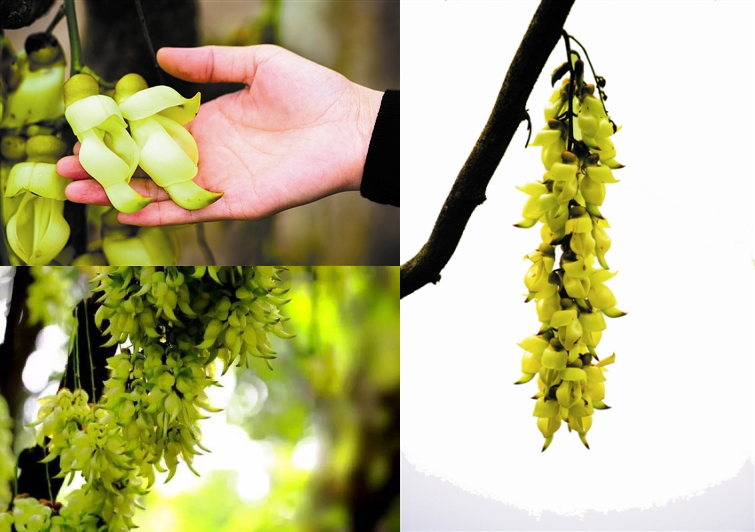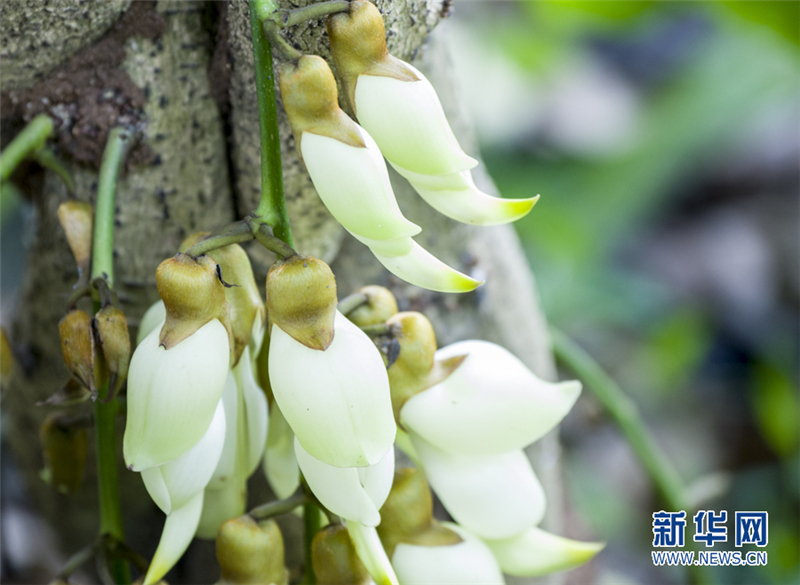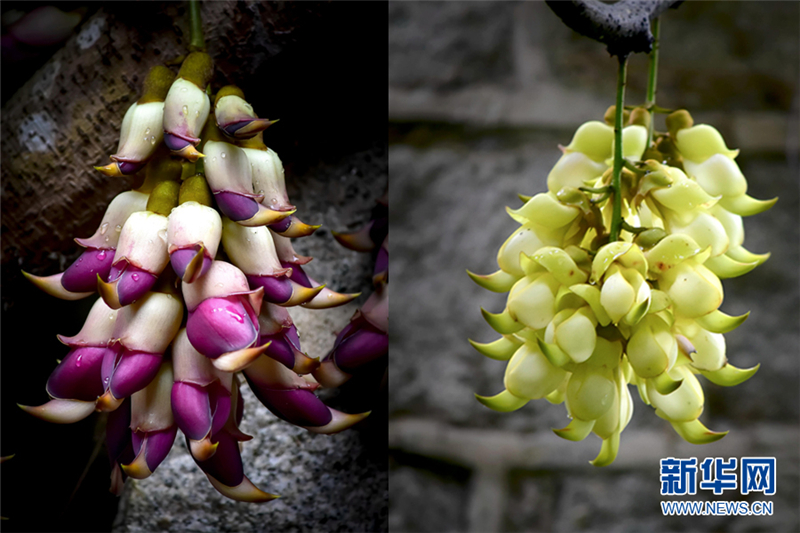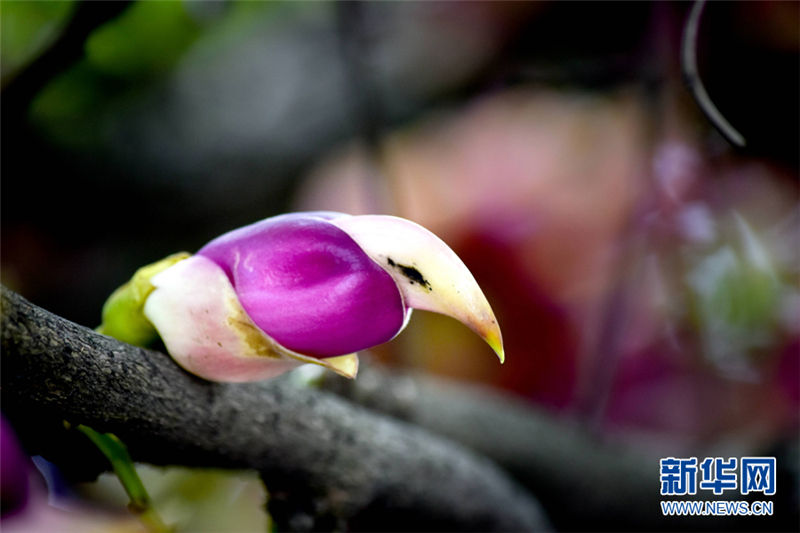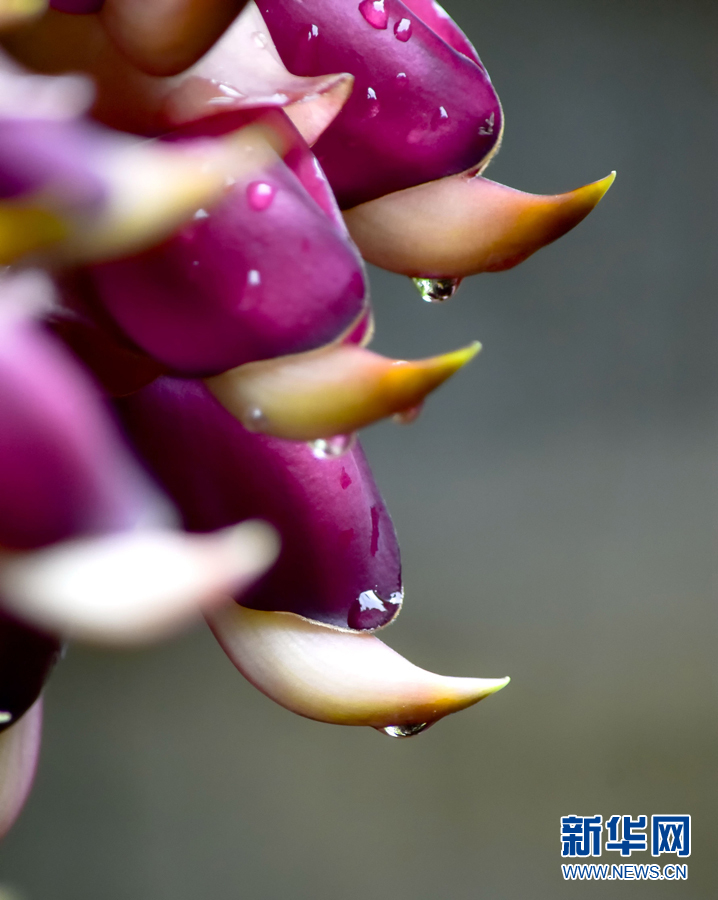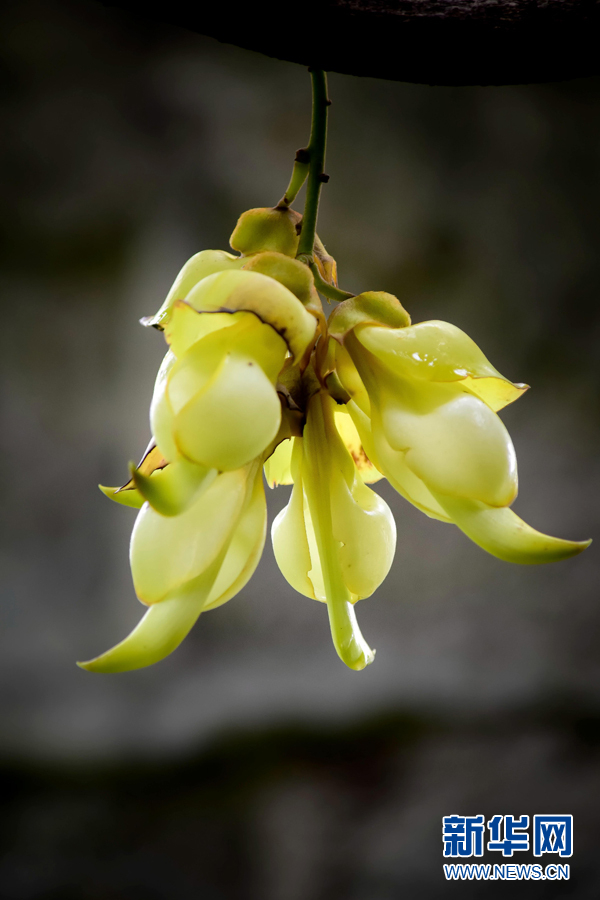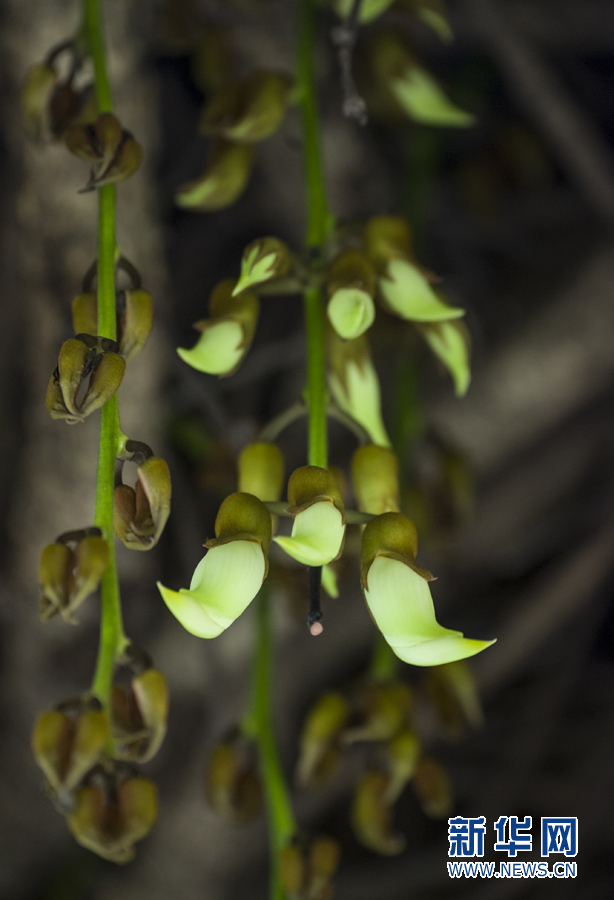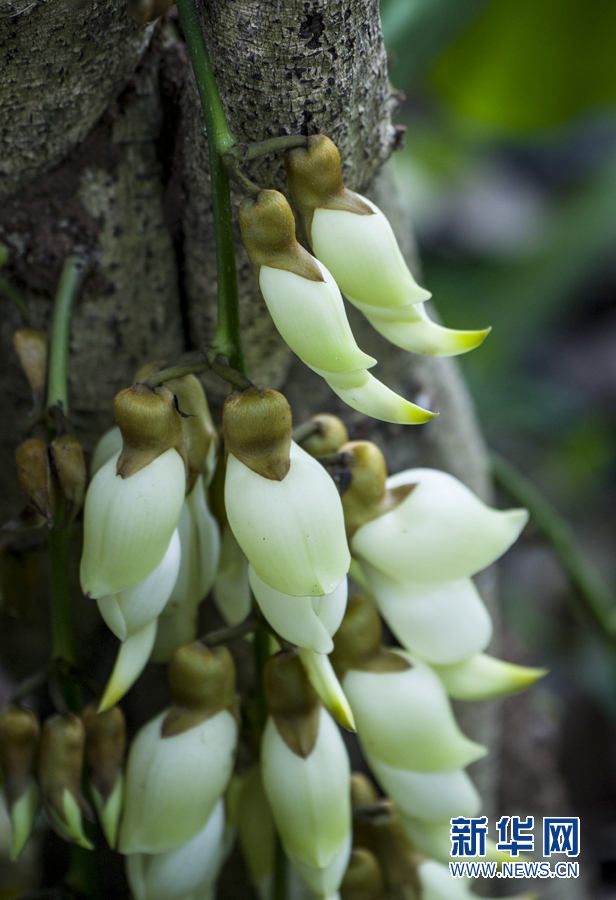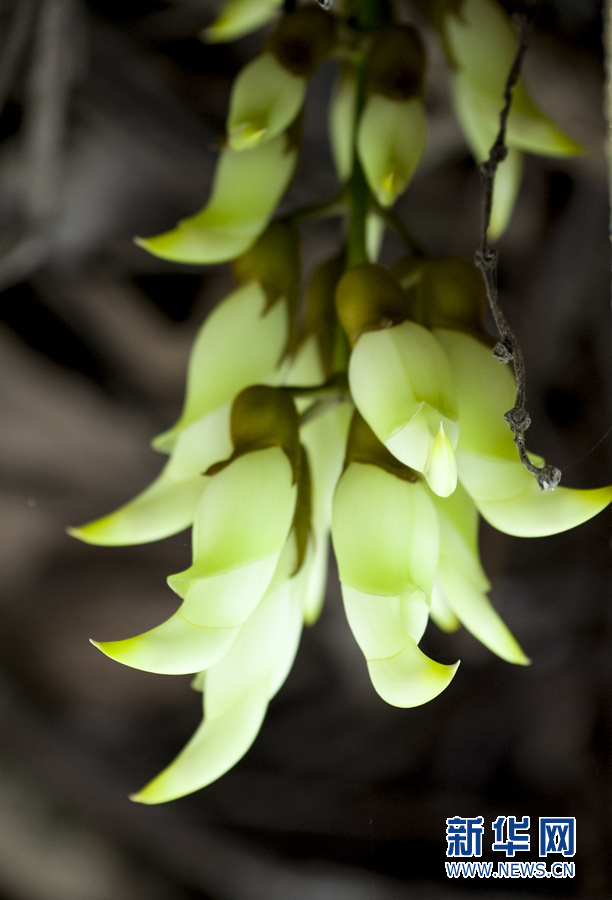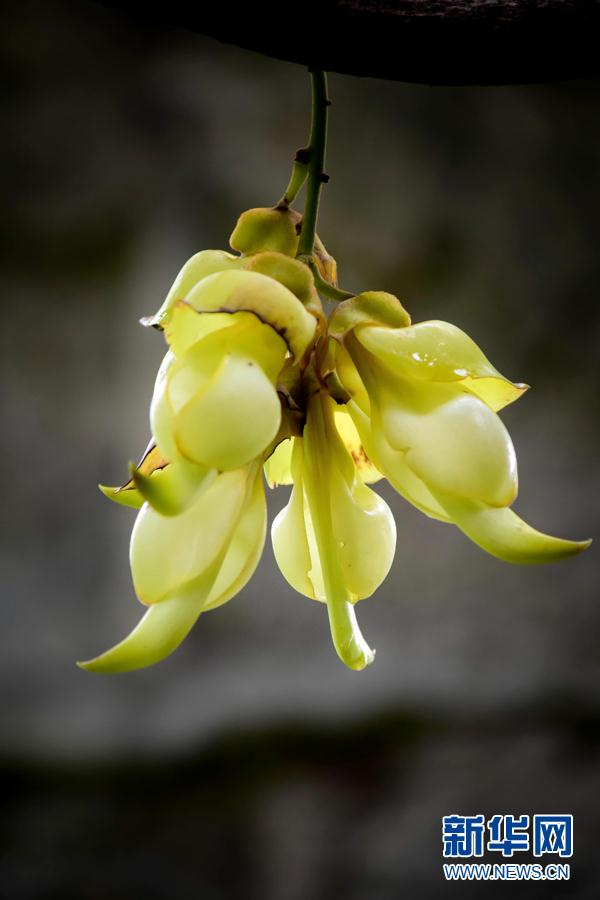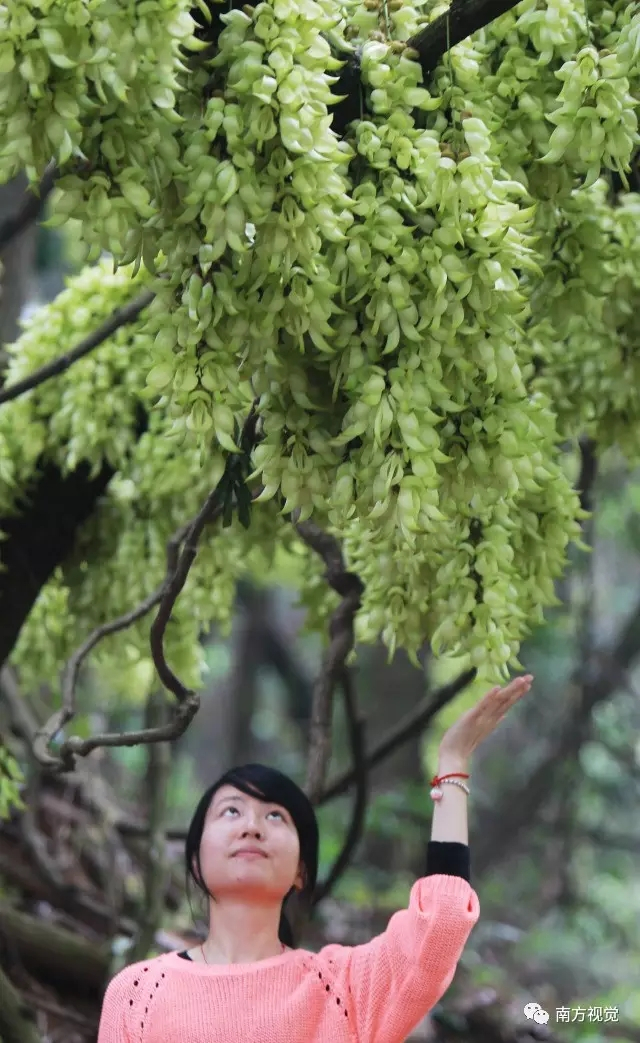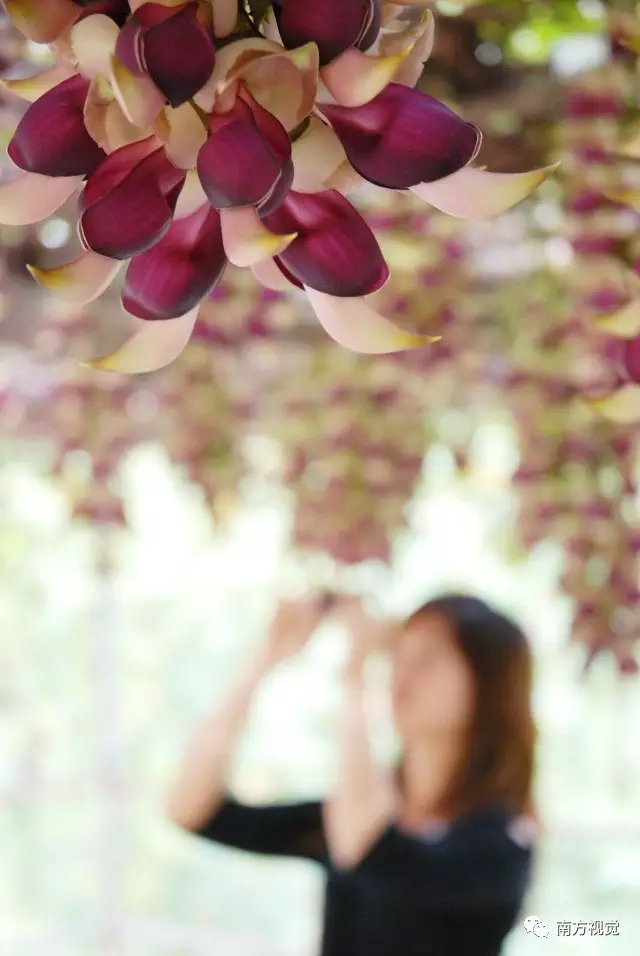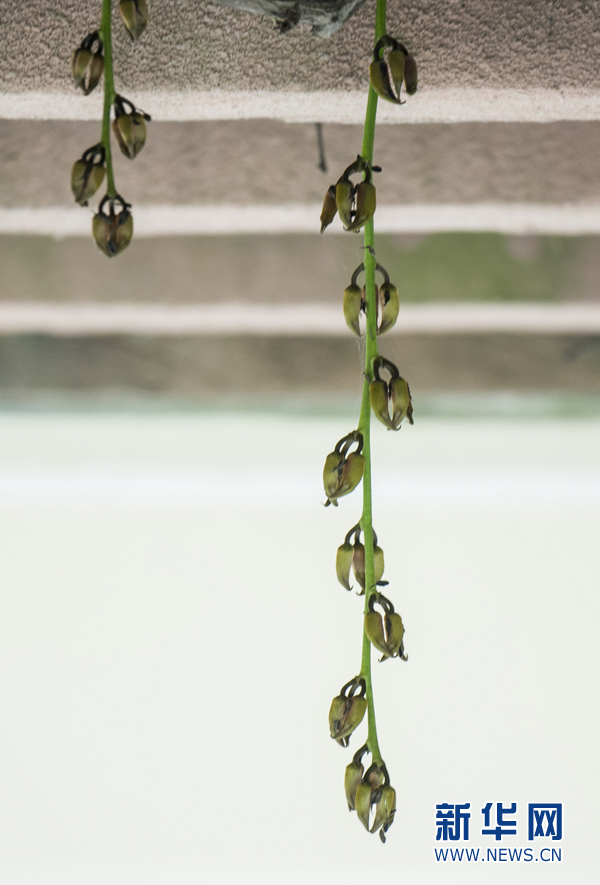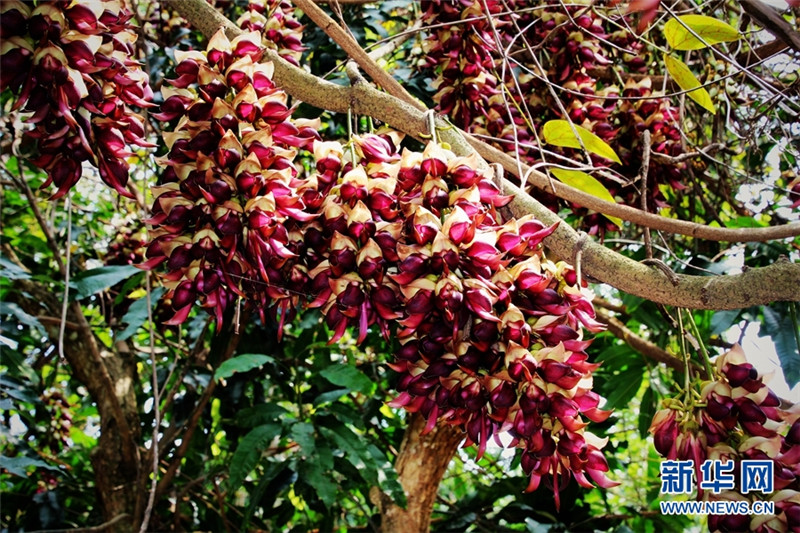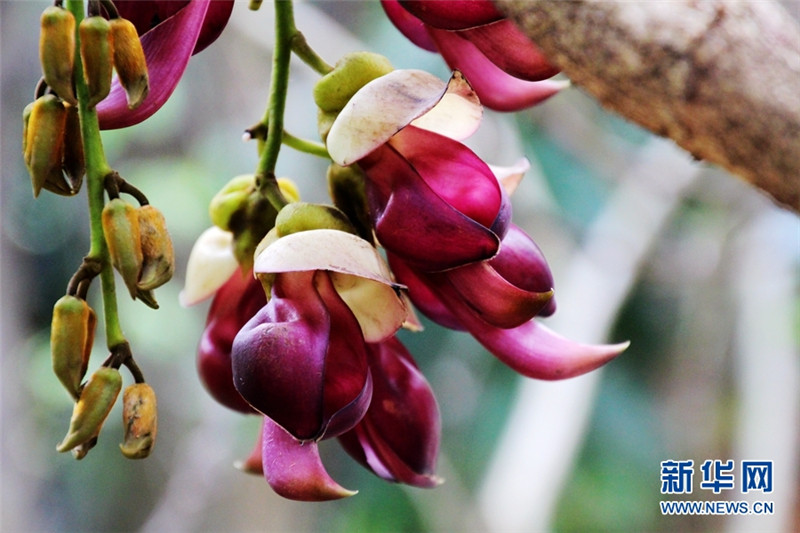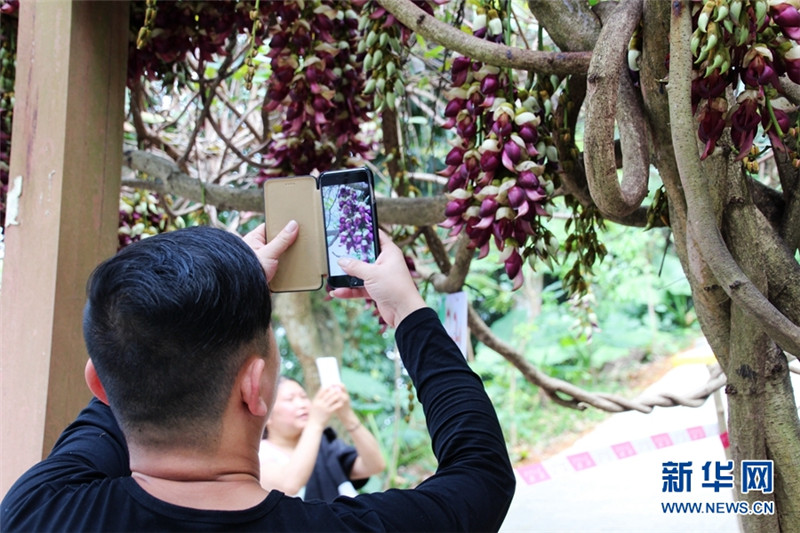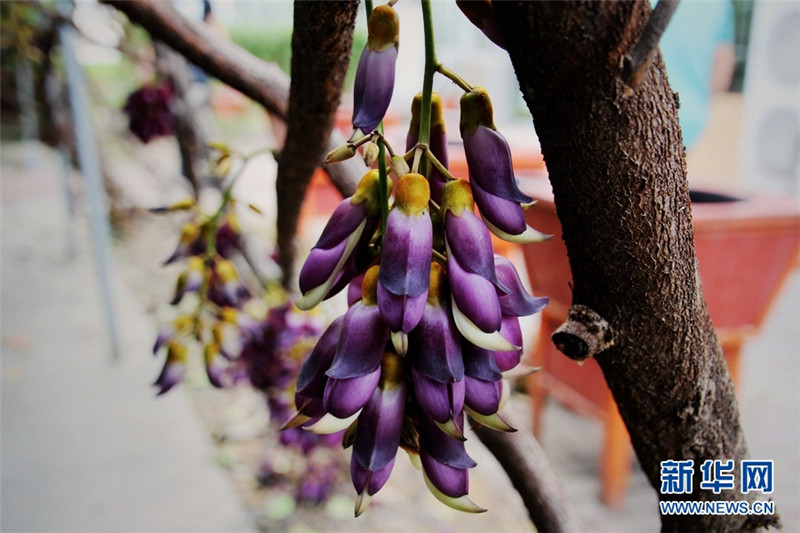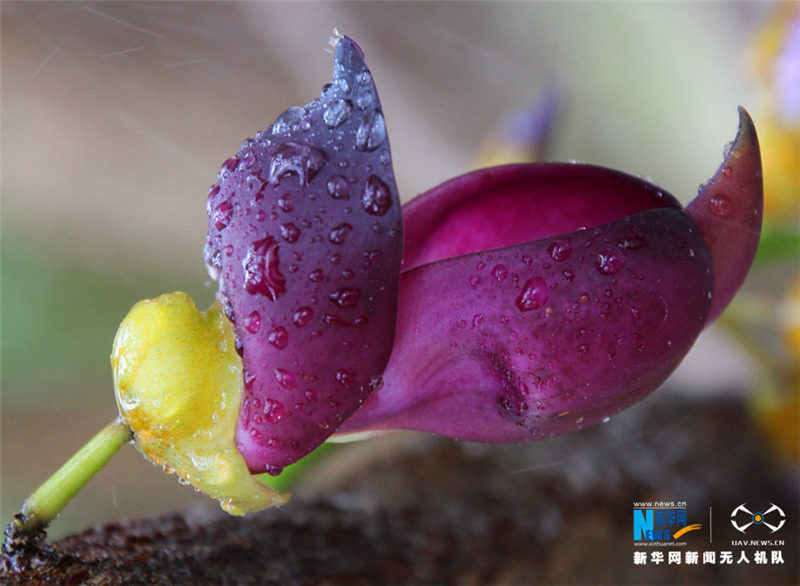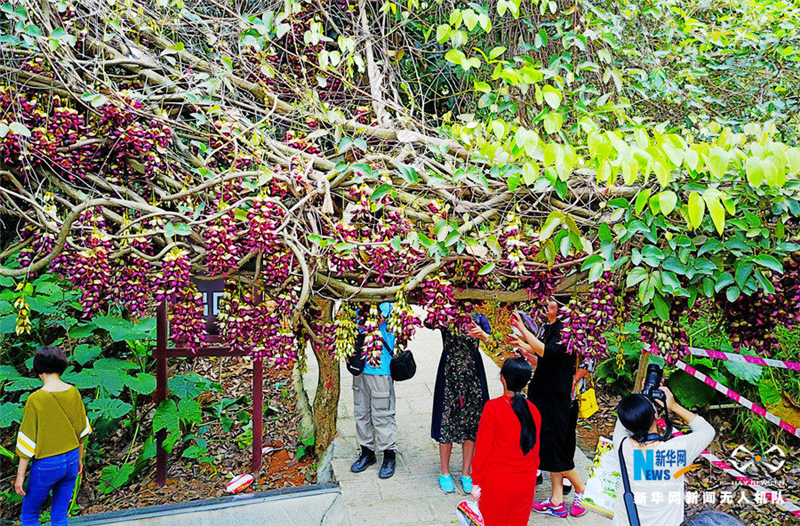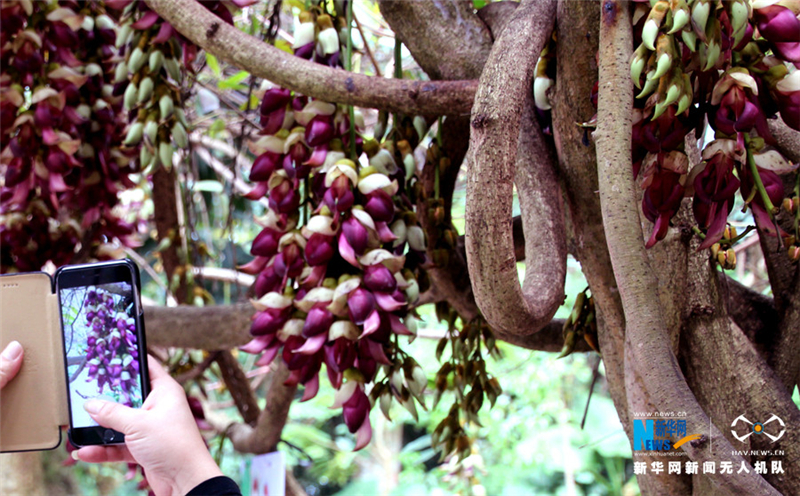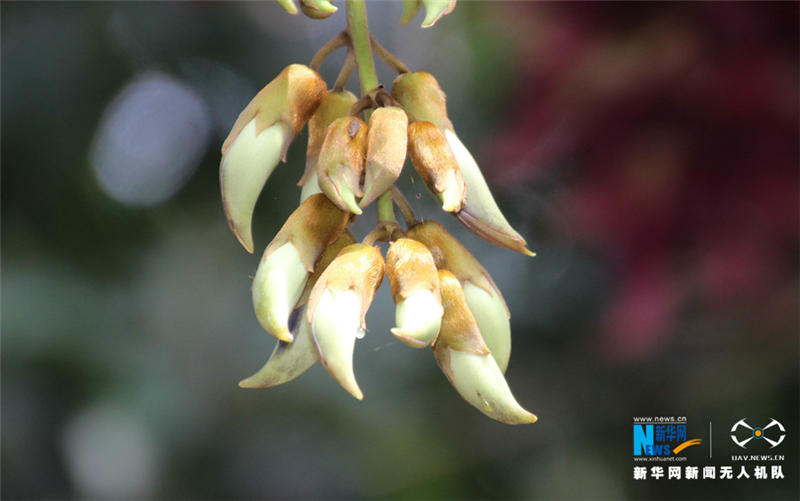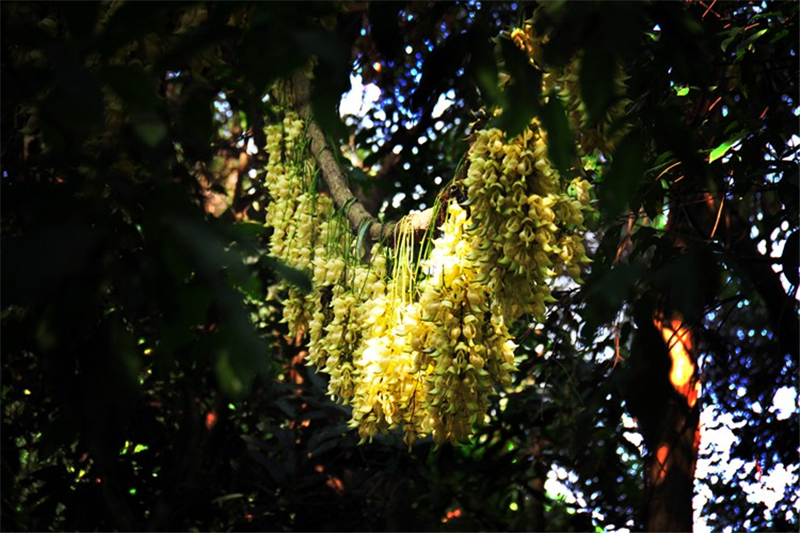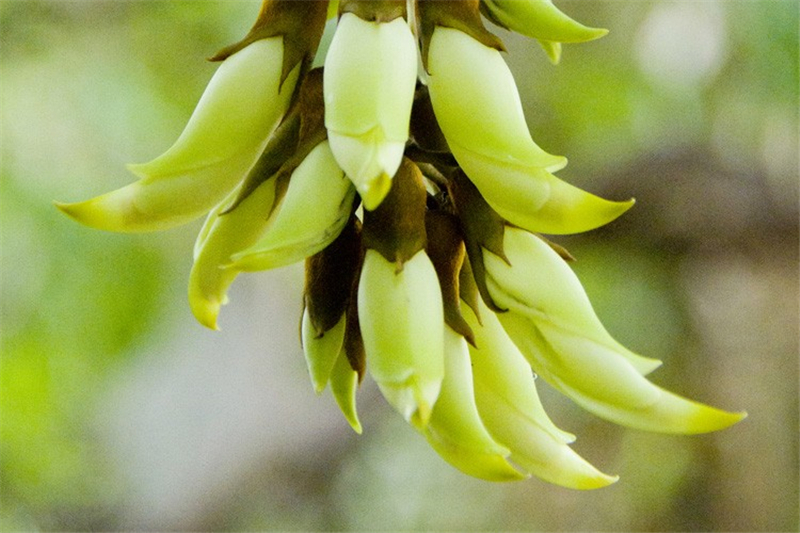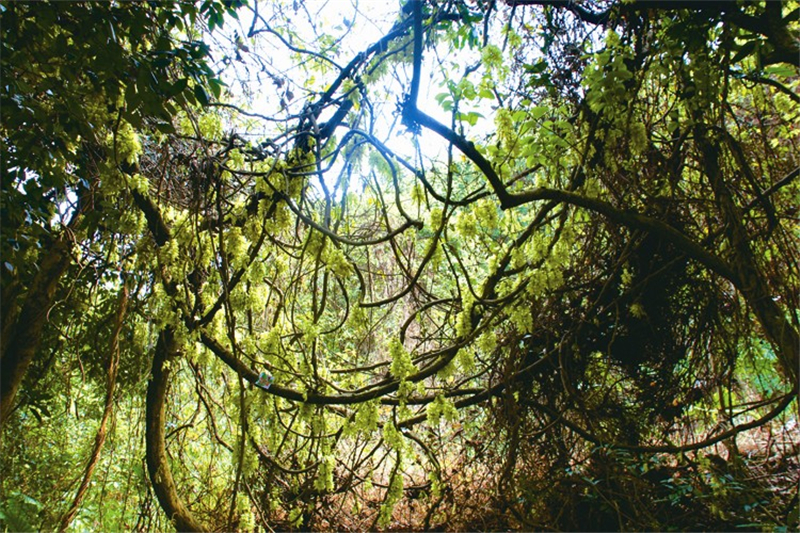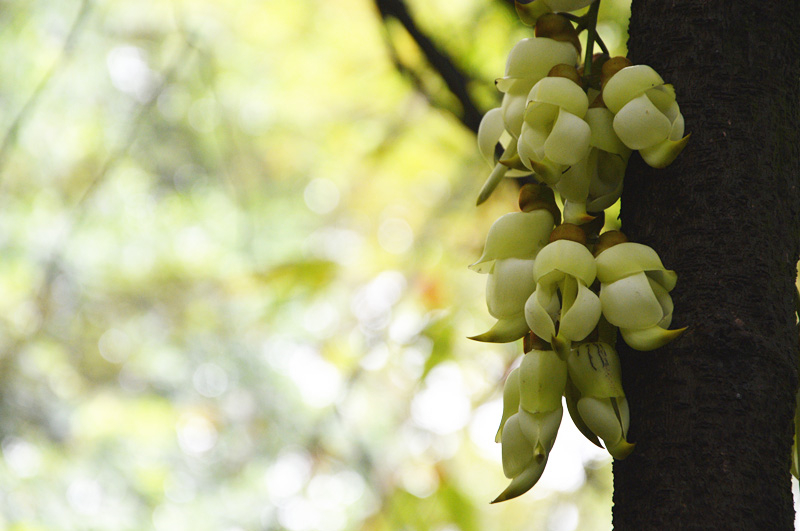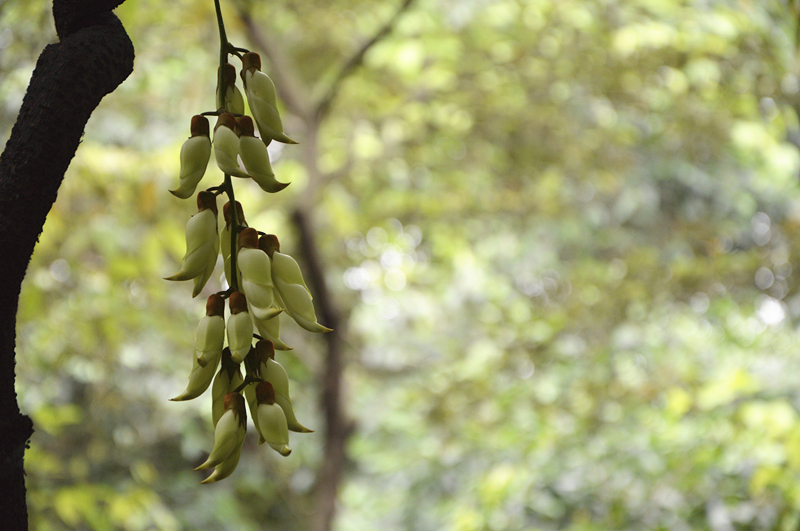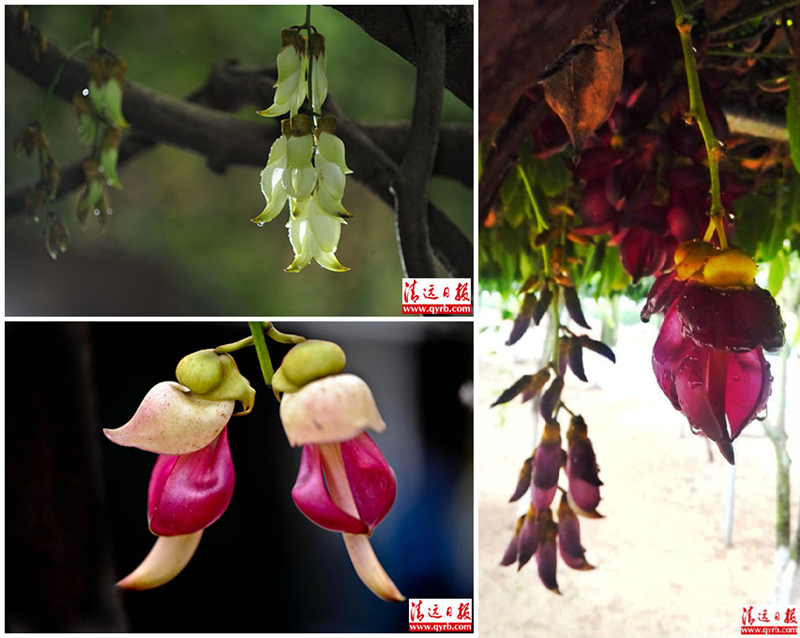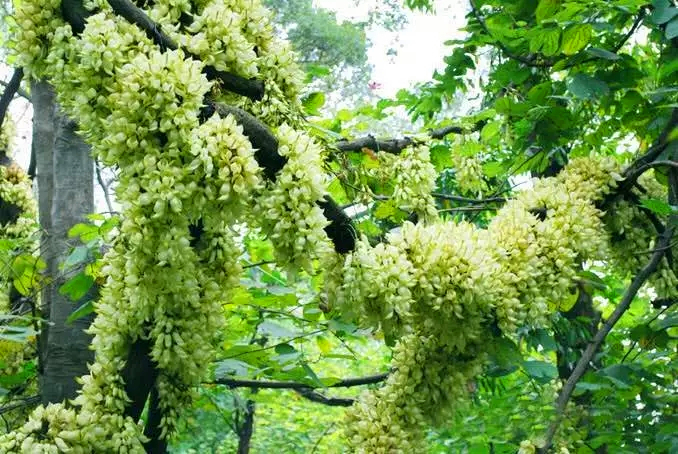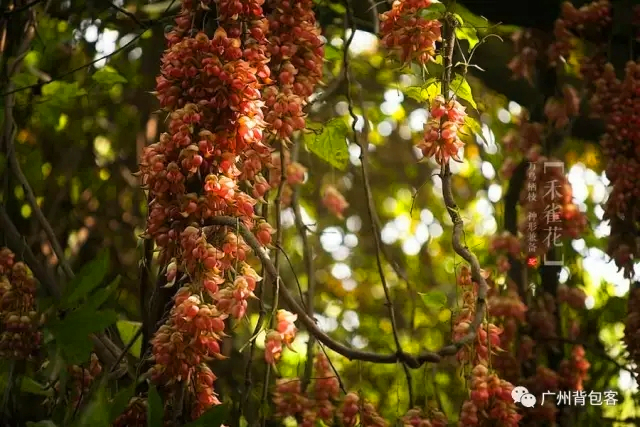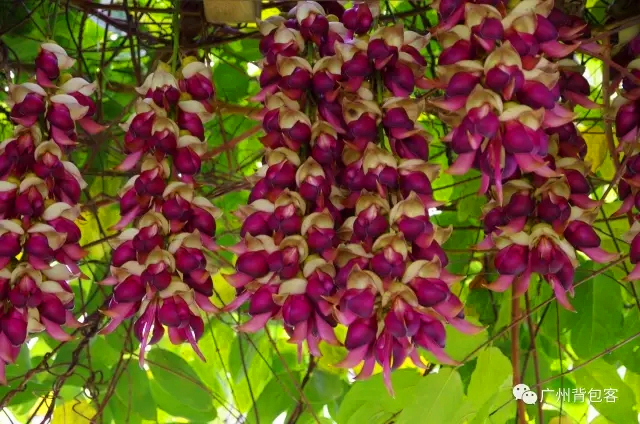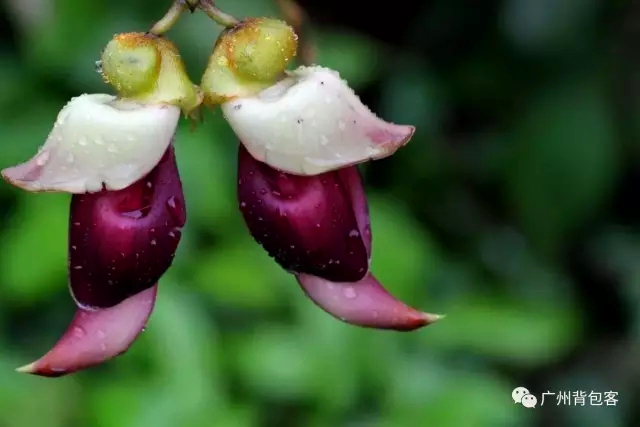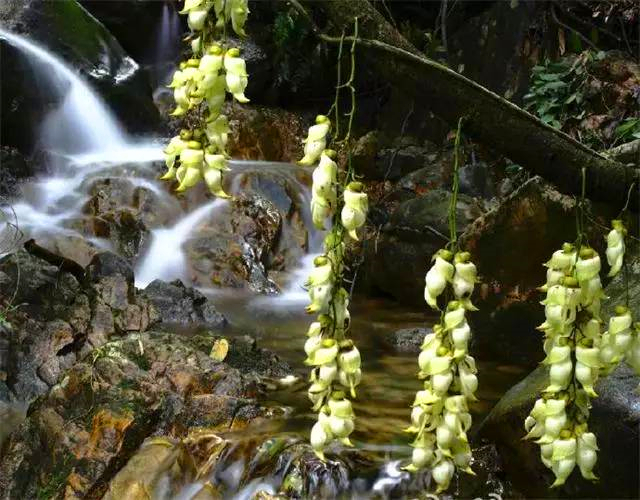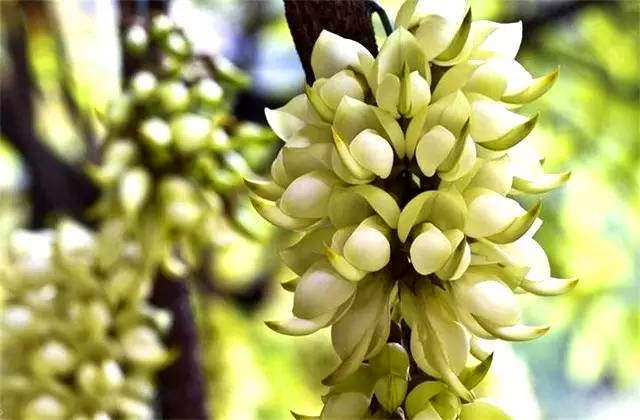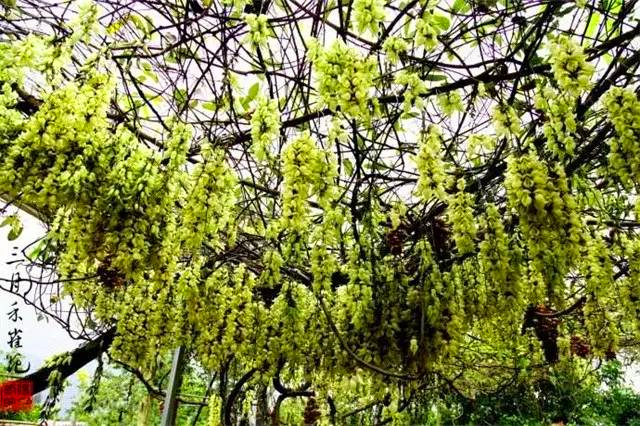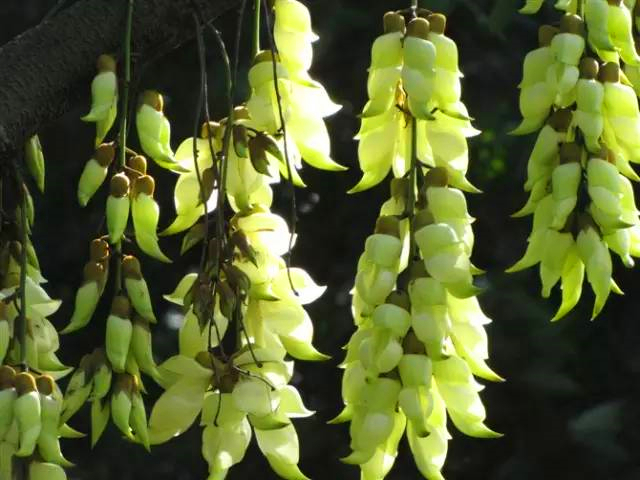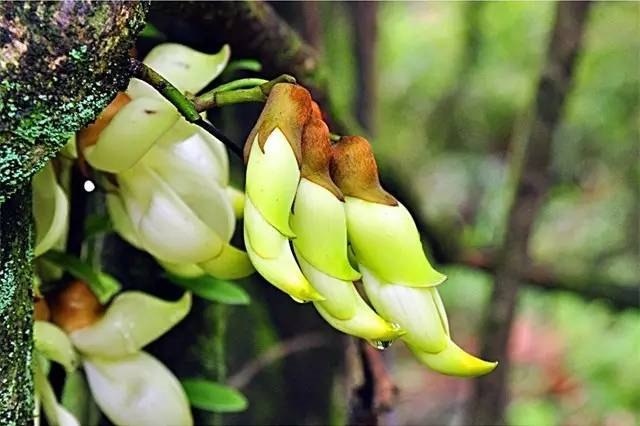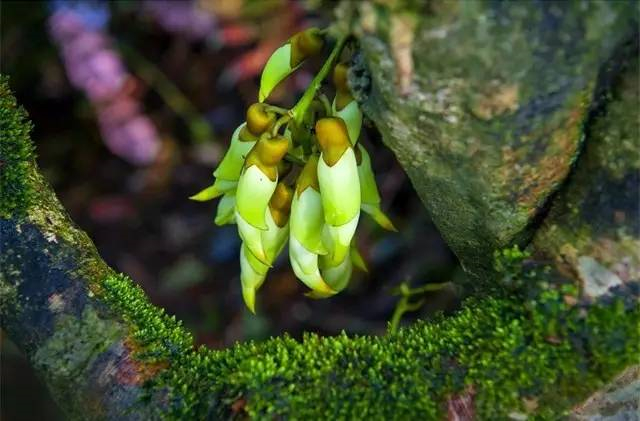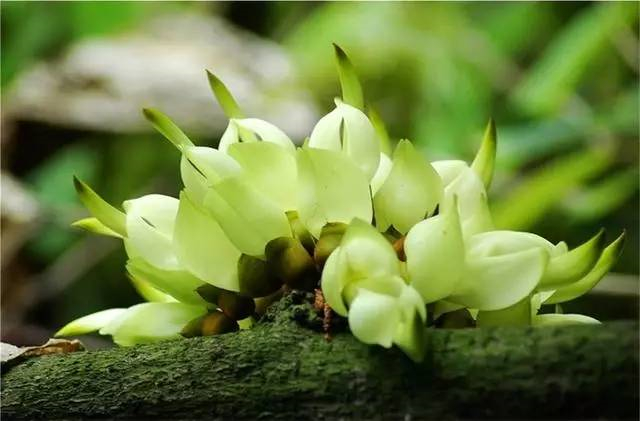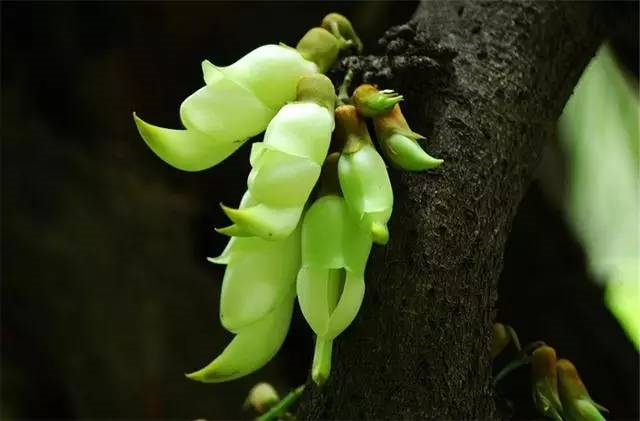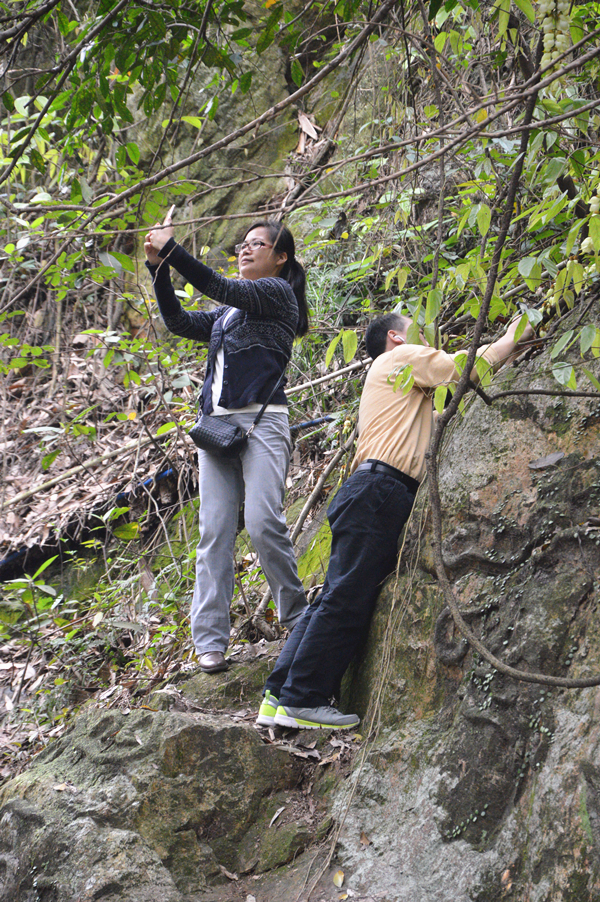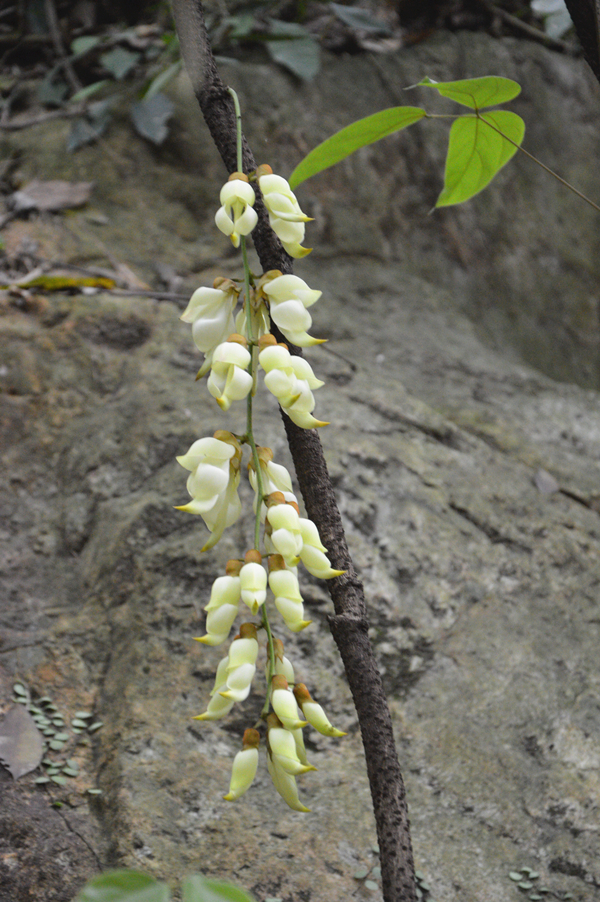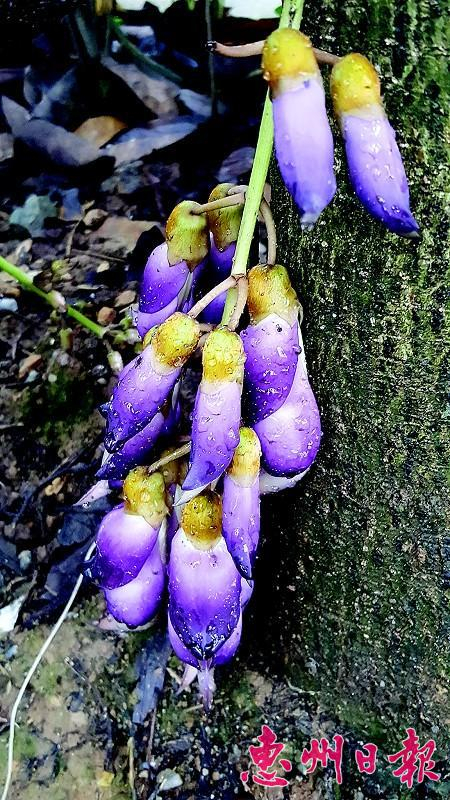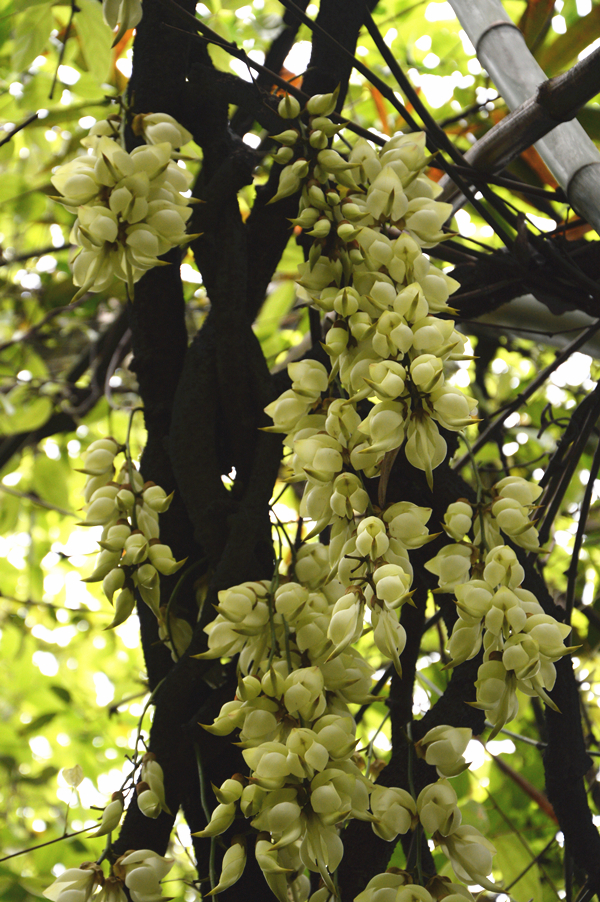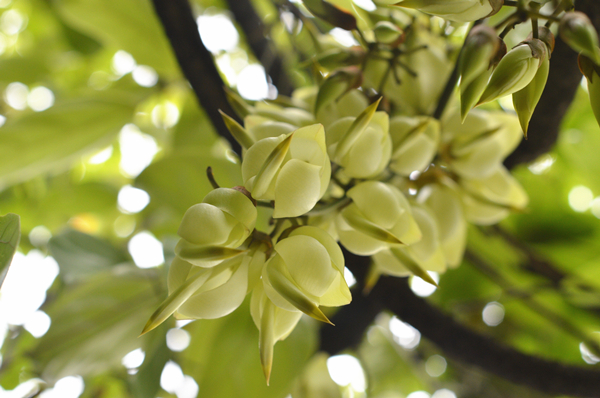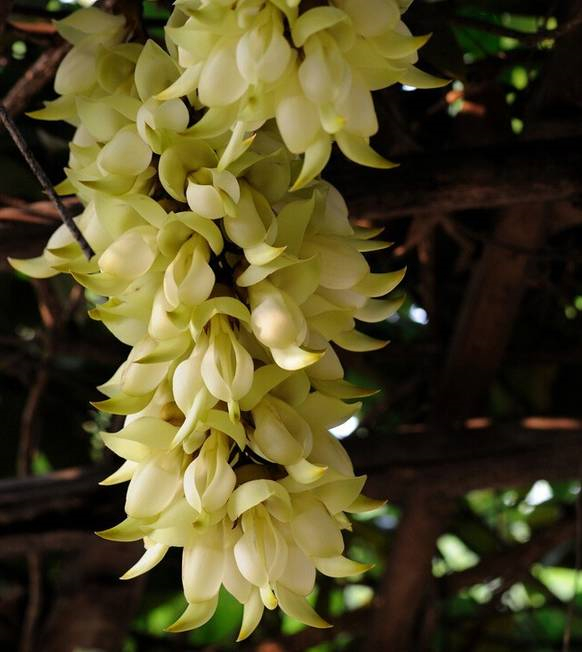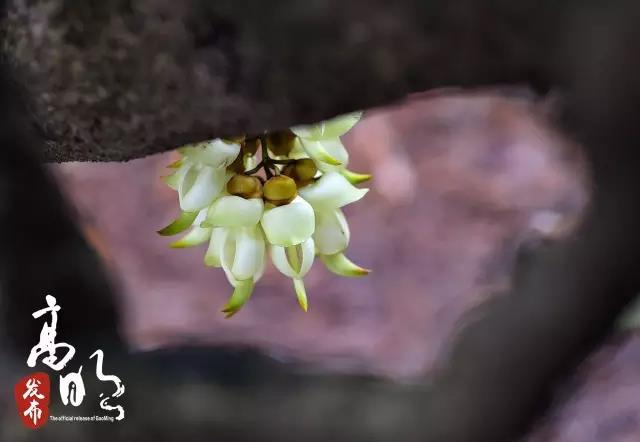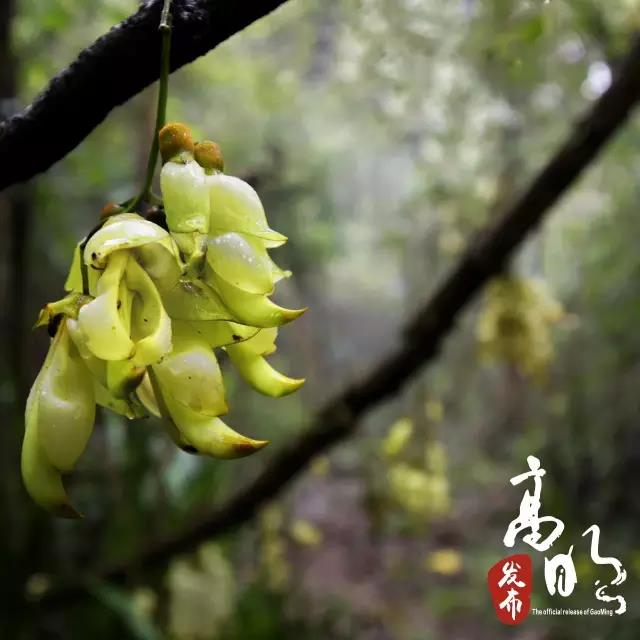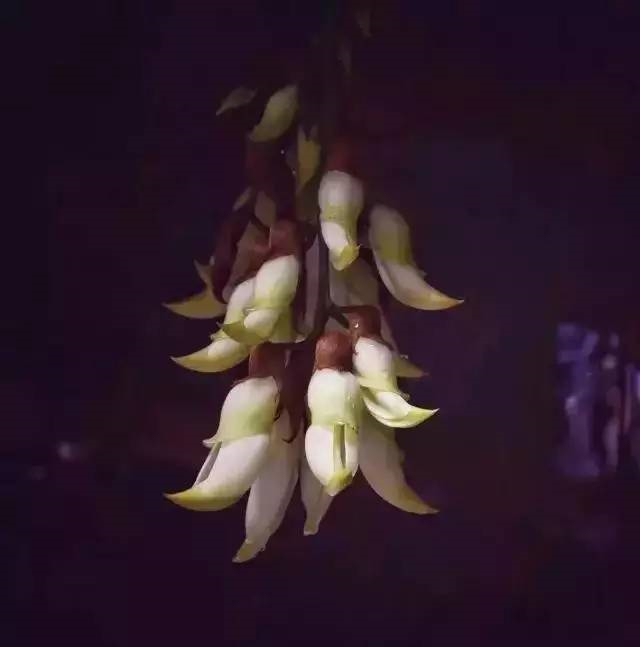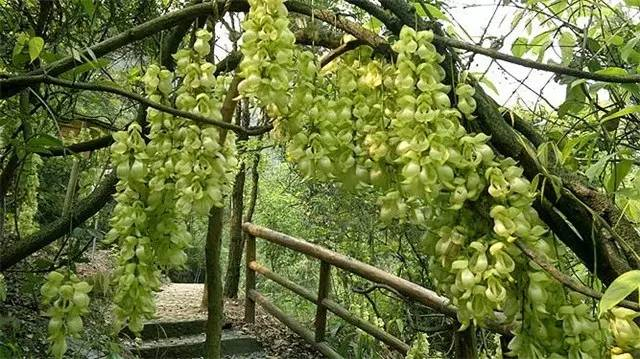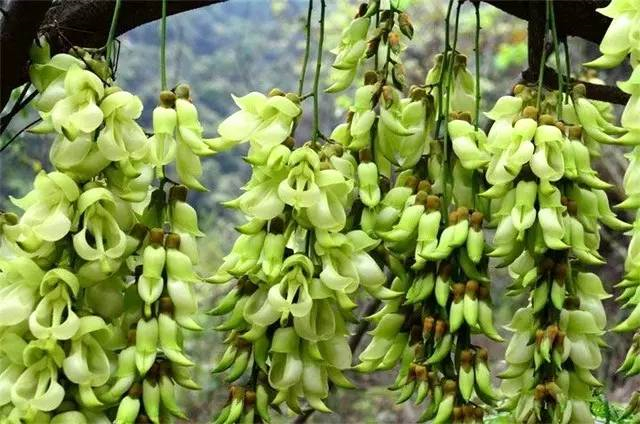[Photo/Xinhua]
Like a flock of ricebirds, Mucuna birdwoodiana are in full bloom in Guangdong around Qingming Festival (April 4, 2017) every year.
Why do the flowers of Mucuna birdwoodiana look like ricebirds? Why are they blooming around Qingming Festival? To answer these questions, we would like to tell you a legend of Mucuna birdwoodiana.
The legend of Mucuna birdwoodiana
Legend has it that in the Ming Dynasty, Iron Crutch Li, one of the Eight Immortals in Chinese mythology, traveled to Gongkeng Temple in Jiangmen. Passing by a field he saw this scene: a flock of ricebirds were flying around the rice field and eating rice. A farmer, seeing that, intended to drive away the birds by waving a broom, but failed. He was afraid that all the rice might be eaten by the birds but could do nothing, so he burst into tears sadly.
Iron Crutch Li stepped up to defend the farmer. He grasped a string of rattan, used his magic power to tie the ricebirds onto the rattan, then hung it onto a tree branch. He allowed the birds to fly out only around Qingming Festival when the granary is nearly empty but the new crop is not yet ripe, so that they wouldn’t be able to steal rice from farmland. Since then, there was not ricebird stealing rice, but Mucuna birdwoodiana blooming around Qingming Festival.
About Mucuna birdwoodiana
Mucuna birdwoodiana belongs to the genus Mucuna and is a state-protected plant in China. Mucuna is a genus of tropical herbs and woody vines, erect or climbing woody plants, having trifoliate leaves and showy flowers in axillary clusters, widespread in tropics of both hemispheres.
The flowers of Mucuna birdwoodiana can be white or greenish or purplish. In Chinese, Mucuna birdwoodiana is also called ricebird flower or sparrow flower (pin yin: he que hua, Chinese: 禾雀花), because its flowers look very much like ricebirds or sparrows in shape. A fresh-picked flower would turn to brown after two or three hours when it looks even like a sparrow. Its fresh petal oozes red fluid if wounded, looking just like a sparrow bleeding.
Attention: People who have trypophobia should think twice before clicking the next pages.
[Photo/Xinhua]
Mucuna birdwoodiana is edible
Mucuna birdwoodiana’s flowers are edible. Fresh flowers are sweet and luscious. They can be cooked with meat to make soup or fried dishes. When cooking them, you have to remove their stamen or pistil. Be aware that not everyone love its odor. Here are some of the dishes you can make with it: crisp fried Mucuna birdwoodiana, boiled Mucuna birdwoodiana with pottage, Mucuna birdwoodiana flower cake, crisp fried Mucuna birdwoodiana with syrup, etc.
Mucuna birdwoodiana flower cake
Use Mucuna birdwoodiana flowers to make some juice, then mix the juice with bean jelly to make some flower cakes. Flowers of different colors can be made into different colored cakes. You can also add some strawberries or dates onto the cake.
Crisp fried Mucuna birdwoodiana with syrup
Wrap the Mucuna birdwoodiana with mixed salted flour, then put them into boiling oil in a deep fryer, and take them out in a few seconds when there is golden foam. Use sugar to make some syrup, then put the fried Mucuna birdwoodiana into the syrup, wrap them with syrup, and it’s done. Prepare some condensed milk to go with the dish. Eat it ASAP in case it gets cold and loses crispness.
[Photo/Xinhua]
Ornamental value
Mucuna birdwoodiana is evergreen and comes into flower in spring. Its flowers are clustered, with about 20 to 30 flowers on one string, some with even more. When Mucuna birdwoodiana are in bloom, the color of the flowers changes as time goes by. At the beginning, it is milk white or pale green; it turns to lemon yellow in full bloom, then pink and orange red at the end of flowering phase. In recent years, purple and violet Mucuna birdwoodiana are more and more popular.
Pharmaceutical value
Mucuna birdwoodiana’s stalk can be used as medicine, with the effect of strengthening bones, smoothing tendon and enriching blood. Its flower can be used as medicine too, which is efficient in decreasing internal heat. However, what calls special attention is that its seeds are poisonous. Do not touch it nor eat it. Please keep an eye on your kids when you are near it.
Flower language
The flower language of Mucuna birdwoodiana is happiness. When Mucuna flowers are in full bloom, it is like hundreds of ricebirds staying together on a branch. It is truly the best embodiment of its language, happiness. The flower phase of Mucuna birdwoodiana is from March to May this year. In the upcoming two weeks (around Qingming Festival), it will be the best time to admire the beauty of it. So how can you enjoy such happiness alone? Go with your family and friends to enjoy such a happy scene in the upcoming days. Seize the day and do not miss this.
[Photo/Xinhua]
Where to view Mucuna birdwoodiana in Guangdong
Mucuna birdwoodiana can be found in many regions around the province. Here are some of the great places for you to admire the beauty of Mucuna birdwoodiana in Guangdong.
Guangzhou
Tianlu Lake Forest Park: the largest site of wild Mucuna birdwoodiana in Guangzhou
Hailed as “the eastern lung of Guangzhou”, Tianlu Lake Forest Park (天鹿湖森林公园) is located in Guangzhou Development District, north Huangpu District. The 50,000-square-meter wild Mucuna birdwoodiana, the largest in Guangzhou, are about to blossom at the end of March and in the beginning of April. Now is the best time to admire its beauty.
There is also a beautiful legend about Tianlu Lake and its Mucuna birdwoodiana. Tianlu, meaning a fairy deer in Chinese, came to travel in the human world with ricebirds who were punished by an immortal for stealing rice from the field. Knowing that ricebirds were tied up on tree, becoming Mucuna birdwoodiana and could only get out during Qingming Festival, tianlu was heartbroken. Tianlu’s tear formed a lake, and tainlu turned into Tianlu Lake, staying with Mucuna birdwoodiana in the human world forever.
Admission: RMB 10 yuan per ticket.
Opening time: 8:30 – 17: 00
Transportation: There are only limited parking lots in the park, so it is highly recommended that visitors take public transportation to get there.
Bus: Guangzhou Bus No. 449, 346, 333A and holiday special line 7.
Self-driving route: 1. Guangshan Highway (towards east) – Tianlu South Road (towards north) – Tianlu Lake Forest Park
2. Guangyuan Expressway (towards east) – Daguan Road (towards north) - Tianlu South Road (towards north) – Tianlu Lake Forest Park
3. Huanan Expressway (towards east) – Guanghe Highway (towards Heyuan, take Exit Badou) – Xingtai Road (towards west) - Tianlu South Road (towards north) – Tianlu Lake Forest Park
A combined photo shows the turquoise Mucuna birdwoodiana at South China Botanical Garden.
South China Botanical Garden: rare and precious turquoise Mucuna birdwoodiana
You may have seen white, pink or purple Mucuna birdwoodiana a lot, but have you ever seen turquoise Mucuna birdwoodiana? Now you can see this rare and precious species in the South China Botanical Garden (华南植物园). Apart from this, you can only see it in Yunnan province’s Xishuangbanna Botanic Garden in China.
The turquoise Mucuna birdwoodiana was introduced from Philippines. It is not cold resistant, fond of being in full sun and hard to survive outdoors in Guangzhou. Its flowering phase only lasts about 20 days. Except for the common Mucuna birdwoodiana and the turquoise ones, there are also rare pink, dark violet and purple & white ones in the garden. So what are you waiting for?
Location: No. 723 Xingke Road, Tianhe District, Guangzhou
Opening Hours: 7:30 – 17:30
Admission: RMB 20 per ticket
Bus: You can take one of the following buses to get there: Bus No. 28, 30, 39, 83, 84A, 84, 494, 534, 535, 564, B12, 10 (Night), 218, 20, 78, B10, B11.
Metro: Take Metro Line 3 and get off at Tianhe Coach Terminal station or Line 6 and get off at Changban station, then transfer to Bus No. B12, 28, 30, 39, 83, 84A, 84, 494, 534, 535, 564, and get off at South China Botanical Garden.
Other spots for viewing Mucuna birdwoodiana in Guangzhou: Conghua Shimen Forest Park (从化石门森林公园), Huadu Stone Mineral Park (花都石头记矿物园), Panyu Dawen Village greenway (番禺大稳村绿道).
[Photo/Xinhua]
Dongguan
Qingxi’s Mucuna birdwoodiana are praised as the finest in Guangdong
Qingxi Town is well-known as “one of the most beautiful towns in China”. It is said the Mucuna birdwoodiana in Qingxi Town are the finest in Guangdong.
Qingxi’s largest community of Mucuna birdwoodiana is situated in Dawang Mountain Forest Park (大王山森林公园), covering an area of 33 acres. It is a famous scenic region for admiring the beauty of Mucuna birdwoodiana. Trees of Mucuna birdwoodiana in the park are extremely thick and rare. Now the Mucuna birdwoodiana at the main entrance of the park and on the mountain are blooming in profusion. It is the perfect time to see the spectacular view of sparrow flowers all over the branches.
Apart from the beautiful scenery, you can buy local products at the tourist service center of the park, including specialties, snacks, souvenirs and distinctive tourist products. Qingxi’s cuisine is also a can’t-miss, braised Hakka goose, brewed Hakka tofu and braised pork with pickles.
Besides, Yingping Mountian Forest Park (银瓶山森林公园) is another great destination to view flowers, especially Mucuna birdwoodiana in Dongguan.
Buses: Take Dongguan Bus No. 5, 10, 23, or 810 to get to Dawang Mountain Forest Park (大王山森林公园); take Dongguan Bus No. 10 or 22 to get to Yingping Mountian Forest Park (银瓶山森林公园);
Self-driving route: enter “东莞清溪大王山森林公园” or “清溪银瓶山森林公园” for the destination into your GPS device.
[Photo/Xinhua]
Qingyuan
Feixia Mountain Scenic Spot : “king & queen of Mucuna birdwoodiana”
In Guangdong, there are many communities of Mucuna birdwoodiana, but one-tree forest covering one to two acres is extremely rare. Behind the Temple of Confucius in Feixia Mountain Scenic Spot (清远飞霞山风景区), there is a “king of Mucuna birdwoodiana”. It covers 3,000 square meters, the perimeter of its trunk is 75cm and the diameter of its roots 30cm. It is estimated that this tree is over 300 years old. Near the “king”, there is a “queen of Mucuna birdwoodiana”, about 260 years old.
On August 23, 2013, Mucuna birdwoodiana was made city flower of Qingyuan. In Qingyuan, Mucuna birdwoodiana can be found both in downtown parks or mountains. Feixia Mountain is about 70 kilometers from Guangzhou, and 26 kilometers from Qingcheng District. It is a famous scenic spot and tourist holiday resort in Guangdong, as well as a holy place of Taoism.
Admission: RMB 60 per ticket.
Opening hours: 7:00 - 18:00
Self-driving route: enter “清远飞霞山风景区” for the destination into your GPS device.
[Photo/Xinhua]
Niuyuzui Scenic Spot: joyful Mucuna birdwoodiana and daunting glass bridge
Niuyuzui Scenic Spot (牛鱼嘴风景区) is known as “the kingdom of Lingnan Mucuna birdwoodiana”. Many themed sceneries are built in the scenic area, such as Mucuna birdwoodiana sightseeing ancient path, Mucuna birdwoodiana rain forest, and Shenquan Valley. It is believed that Shenquan Valley is the origin place of ancient Mucuna birdwoodiana rattans. Visitors can enjoy the sight of the famous “king” of ancient Mucuna birdwoodiana.
Starting from March 25, the glass bridge in Niuyuzui has been open to the public. The bridge is 250 meters long, 200 meters high from the ground. How high is that? It is about 60 storeys high. By the way, don’t forget to taste local farm-flavored dishes, such as white cut chicken and steamed fish, to calm you down after visiting the bridge.
Admission: RMB 75 per ticket for the scenic spot; ticket price for the glass bridge should be inquired at the scene.
Bus: Take Qingyuan Bus No. 24 to get to the scenic spot.
Self-driving route: enter “清远牛鱼嘴风景区” for the destination into your GPS device. It takes about one hour from Guangzhou to the scenic spot.
The glass bridge in Niuyuzui Scenic Spot.
[Photo/Xinhua]
Shampoola Tourism & Holiday Forest: body painting to promote city flower
The Shampoola Tourism & Holiday Forest resort (森波拉度假森林) is holding the 5th Mucuna Birdwoodiana Food Festival until the midmonth of April. During the festival, visitors can enjoy beautiful flower scenery, taste flower dishes, and take flower bath. This flower and fruit feast offers Mucuna birdwoodiana flower bath, cherry flower bath, vegetable-and-fruit enzyme hot spring, dragon fruit hot spring, bottle gourd art hot spring, body painting of Mucuna Birdwoodiana, and ten different Mucuna birdwoodiana dishes.
Admission: RMB 80 per ticket for sightseeing, RMB 158 per ticket for hot spring (reservation should be made at least one day ahead.)
Self-driving route: enter “森波拉度假森林” for the destination into your GPS device. It takes about 50 minutes from Guangzhou to the resort.
[Photo/Xinhua]
Shenzhen
Herbie Camp Town: Free tour guide service for viewing Mucuna birdwoodiana
This year, Pingshan District Outdoor Mountaineering Association offers free consulting services to citizens and tourists who go to view Mucuna birdwoodiana in Herbie Camp Town (金龟露营小镇). Free tourist guide service will be offered at 10:30 and 16:00 every Saturday and Sunday.
Service call: 0755-89552296
Bus: Take Bus No. 818, 833, M220, M279, M357, M426 and get off at Jingui Village, then walk about 500 meters to get to the Herbie Camp Town. Or take Bus No. B833 and get off at Herbie Camp Town.
Self-driving route: enter “金龟露营小镇” for the destination into your GPS device.
Maluan Mountain Scenic Region: Take Shenzhen Bus No. 833, get off at Maluan Mountain Country Park, and then walk 982 meters to get to Maluan Mountain Scenic Region(马峦山景区); or take Bus No. B762, B886, M297, get off at Maluan Mountain Suburban Park, then walk 750 meters to get to to the mountain.
Tanglang Mountain Country Park: Take Shenzhen Bus No. 19, 104, 201, 235, 240, 316, 325, 326, 334, 368, b606, b710, m203, m369, n8, and get off at Reeducation Center station, then walk about 400 meters to get to Tanglang Mountain Country Park (塘朗山郊野公园).
Attention: The Mucuna birdwoodiana in all these spots are located inside the reserve area. Tourists need to walk and climb through some unopened areas. At least two hours is needed. So please prepare enough water, wear comfortable sneakers and climbing clothes.
[Photo/Xinhua]
Jiangmen
Guifeng Mountain National Forest Park: wild Mucuna birdwoodiana accompanied by old pines and rare stones
The flower sea of Mucuna birdwoodiana in Guifeng Mountain National Forest Park (圭峰山国家森林公园) is the most flourishing in Jiangmen. Viewing the flowers from a distance, it looks like a flock of ricebirds hidden in the vines. Situated in the southwest of the Pearl River Delta, Guifeng Mountain National Forest Park offers a diversity of dramatic scenery.
Opening Hours: 8:00 – 17:30
Admission: RMB 15 per ticket
Long-distance bus: 1. Take a bus at Guangzhou Provincial Bus Station or Fangcun Bus Station to Xinhui Bus Station, then transfer to Bus No.3 and get off at Mount Guifeng Station;
2. Take a bus at Guangzhou Provincial Bus Station to Zhongxinnan Bus Station, then take Bus No. 8 (from Dongjia to Ziyunguan) to the mountain directly.
Self-driving route: enter “江门圭峰山国家森林公园” for the destination into your GPS device.
[Photo/Xinhua]
Zhaoqing
Seven Star Crags Scenic Spot: seven-color Mucuna birdwoodiana are waiting for you
On Pangu Mountain inside Seven Star Crags Scenic Spot (肇庆七星岩), various Mucuna birdwoodiana are blooming. There are red, yellow and other multi-cloured Mucuna birdwoodiana. On the north side of Panwang Temple, you can see rarely seen seven-color Mucuna birdwoodiana.
Admission: RMB 78 per ticket
Bus: Take Zhaoqing Bus No. 19 to get to the west gate of Seven Star Crags.
Self-driving route: enter “肇庆七星岩” for the destination into your GPS device.
[Photo/Xinhua]
Foshan
Sanshui Jiudao Valley: The number of Mucuna birdwoodiana in Jiudao Valley (三水九道谷) is quite large,which is rare in Foshan. Now Mucuna birdwoodiana have covered all the valley. Many of the vines are at least 200 years old.
Admission: RMB 138 per ticket
Bus: Take Foshan Bus No. 616 A or B to get off at Jiudao Valley Entrance station.
Self-driving route: enter “佛山市三水九道谷自然生态旅游区” for the destination into your GPS device.
Gaoming Laoxiang Mountian: Wild Mucuna birdwoodiana are hidden in a 200 years old primeval and secondary forest in Laoxiang Mountian (高明老香山). It takes about one hour walking to get to the spot in the mountain.
Bus: Take Foshan Bus No. 502, 501, 506, k508 and get off at Heshui Coach Station, then transfer to No. 582 and get off at Wangtian Village station.
Self-driving: enter “高明区更合镇旺田村” for the destination into your GPS device.
[Photo/wechat account: nfrbsy]
Fairy Cave Scenic Spot (仙人洞) is located in Fairy Cave Village in the south foot of Dawu Mountain, Shenzhen Town, Gaozhou, Maoming (茂名市高州深镇镇仙人垌村). It is cloud-covered for most of the time, just like a fairyland. Along the hiking trail are full of wild Mucuna birdwoodiana, some of which are ancient ones. There is also a wild azalea forest at the mountaintop, red, purple, yellow and pink azalea blooming.
Huguangyan Scenic Area in Zhanjiang (湛江湖光岩风景区): White Mucuna birdwoodiana in full bloom, accompanied by maar volcanic geological landforms, coastal and structural geological landforms.
Upper village of Hecha Col, Beigu Village, Xinzhou Town, Yangdong District, Yangjiang (阳江市阳东区新洲镇北股村禾叉坳上自然村): Mucuna birdwoodiana are in full blossom and gorgeous though hidden in the hills.
[Photo/wechat account: nfrbsy]
Honghua Lake Scenic Spot in downtown Huizhou (惠州市区红花湖景区): Purple Mucuna birdwoodiana are waiting for you here and another batch of them will be planted soon.
Huanglongyan She Nationality Custom Scenic Spot in Heyuan (河源黄龙岩畲族风景区): Bright yellow and purple bi-color Mucuna birdwoodiana, mysterious karst cave, unique dance and culture of She Nationality.
Jiaoling County, Meizhou (梅州市蕉岭县): An ancient Mucuna birdwoodiana with the biggest vine in Meizhou was found in Changtan Town in 2007, and many Mucuna birdwoodiana can be seen around the county.
[Photo/wechat account: nfrbsy]
Mucuna birdwoodiana in Huguangyan Scenic Area in Zhanjiang. [Photo/Xinhua]
Mucuna birdwoodiana in Dawang Mountain Forest Park, Qingxi Town, Dongguan. [Photo/Xinhua]
Mucuna birdwoodiana in Dawang Mountain Forest Park, Qingxi Town, Dongguan. [Photo/Xinhua]
Mucuna birdwoodiana in Dawang Mountain Forest Park, Qingxi Town, Dongguan. [Photo/Xinhua]
Mucuna birdwoodiana in Dawang Mountain Forest Park, Qingxi Town, Dongguan. [Photo/Xinhua]
Mucuna birdwoodiana in Dawang Mountain Forest Park, Qingxi Town, Dongguan. [Photo/Xinhua]
